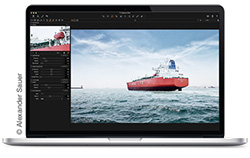Capture One Pro 8

 Professional RAW Converter
Professional RAW Converter
It was by no means a slow application, but version 8 of Capture One Pro has been updated with a new processing engine. I got my hands on a fresh copy and found several improvements that make it the choice of the professional, starting with its pristine, neutral demosaicing algorithm.
Capture One Pro 8's new processing engine makes for an even faster processing speed than its predecessor, even on somewhat older machines like my three-year-old iMac. But speed isn't everything: the Capture One engineers tried harder and improved a lot of Capture One's already impressive functionality.
Improvements that caught my eye include better image quality when using the High Dynamic Range (HDR) tool, which lets you restore detail in highlights and shadows without introducing noise. Another impressive improvement is much better image quality when working with high ISO images. I tested the new Luminance Noise Reduction with an image shot at ISO 3200 and compared the results with a DxO PRIME reduction. Much to my surprise, there was hardly any difference. The improved luminance noise-reduction algorithm is one of the main reasons why you'll want to check out version 8.
The addition of a Natural Clarity method is good, but there's only a subtle difference between that and the Neutral setting. Not so subtle, and absolutely a winner, is the expansion of the number of corrections, edits, and effects you can apply to local areas using the Layers feature. There are now three types of layers: adjustment (the one we know from previous versions), healing, and cloning. You can freely switch between the three. The two new layer types offer the same sort of functionality as the Clone Stamp and Healing Brush tools in Photoshop, but they seemed easier to use for someone who has never worked with these types of brushes before. You can also apply more local adjustments, including White Balance, HDR, Noise Reduction, and Purple Fringing.
Film Grain is new, too, but that's the one feature I wasn't so sure about. Capture One Pro 8 doesn't try to emulate specific films (e.g., Kodak TRI-X 400), but only draws inspiration from them. Phase One argues that there are simply too many variables. For example, a film from the '50s will look different than the same product in the '70s. There are questions of how old it was before it was used, how it was developed, etc.; hence, the more generic approach of adding Cubic Grain, Smooth Grain, Silver Rich, and others. For a full film stock emulation, users should create a creative style and fiddle with the Black & White conversion sliders, the Curve panel, and Film Grain.
Finally, the digital asset management (DAM) part of Capture One Pro 8 is slowly maturing. You can now import your Apple Aperture Library straight into a Capture One catalog. Catalogs can have hierarchical keywords, catalog folders can be synchronized, etc. Sessions, which are especially useful for tethered shooting, are still available and the import functionality has been differentiated between catalogs and sessions. Metadata editing has improved and metadata can be edited in the Filters panel.
For Capture One Pro 8, Phase One has expanded tethered functionality. Support for many cameras has been added—tethered support for select Sony cameras, for example—but obviously the most sophisticated support is still to be had with Phase One cameras.
Company: Phase One
Price: $299; Upgrade: $99; Subscription: $10/month
Web: www.phaseone.com
Rating: 5
Hot: Noise reduction; local adjustments; tethered shooting
Not:
